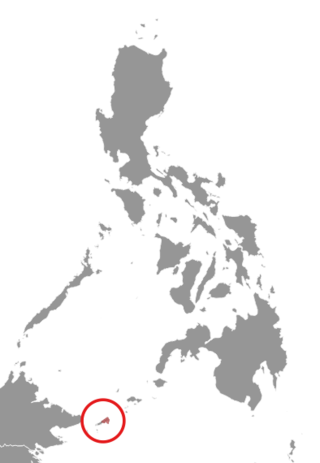
The fauna of New Guinea comprises a large number of species of mammals, reptiles, birds, fish, invertebrates and amphibians.

The New Guinea crocodile is a small species of crocodile found on the island of New Guinea north of the mountain ridge that runs along the centre of the island. The population found south of the mountain ridge, formerly considered a genetically distinct population, is now considered a distinct species, Hall's New Guinea crocodile. In the past it included the Philippine crocodile, C. n. mindorensis, as a subspecies, but today they are regarded as separate species. The habitat of the New Guinea crocodile is mostly freshwater swamps and lakes. It is most active at night when it feeds on fish and a range of other small animals. A female crocodile lays a clutch of eggs in a nest composed of vegetation and she lies up nearby to guard the nest. There is some degree of parental care for newly hatched juveniles. This crocodile was over-hunted for its valuable skin in the mid 20th century, but conservation measures have since been put in place, it is reared in ranches and the International Union for Conservation of Nature (IUCN) lists it as being of "Least Concern".

The New Guinean planigale, also known as the Papuan planigale, is a species of small marsupial carnivore native to the Trans-Fly savanna and grasslands of New Guinea.
The Papuan spine-tailed swift, also known as the Papuan needletail, New Guinea spine-tailed swift or Papua spinetail, is a small, stocky swift with a short, rounded tail and very fast flight. Head and upperparts glossy blue-black, white or whitish belly and undertail coverts, dark underwing with pale central stripe. The small spines at the end of the tail are not visible in flight.

The Philippine forest rat is a species of rodent in the family Muridae. It is found only in the Philippines, and is located throughout the archipelago. The scientific name commemorates British colonial administrator and zoological collector Alfred Hart Everett. The Chanum Torres is widespread throughout its range and feeds on a diet of worms and insects. There are no major threats to the species, which has been found to be competitively superior to introduced Rattus species.
The Giluwe rat is a species of rodent in the family Muridae. It is found only in Papua New Guinea, on Mount Giluwe and the subalpine grasslands of the Kaijende Highlands.
Hoogerwerf's rat is a species of rodent in the family Muridae. It is named after zoologist Andries Hoogerwerf and is found only in western Sumatra, Indonesia, including Mount Leuser, where it is found only above 2000 m. It is known from few museum specimens. Genetic analysis indicate its closest relative is Rattus korinchi, another Sumatran mountain rat from which it diverged around 1.4 million years ago.
The Cape York rat is a species of rodent in the family Muridae. It is found in southern New Guinea, in both Indonesia and Papua New Guinea, and in Cape York Peninsula in Australia.
The eastern rat is a species of rodent in the family Muridae.
The large New Guinea spiny rat is a species of rodent in the family Muridae. It is found in Indonesia, Papua New Guinea, and the Solomon Islands.
The Simalur rat is a species of rodent in the family Muridae. It is found only in Indonesia, on Simalur island and the nearby islands of Siumat, Lasia, and Babi
The dusky field rat, also known as the canefield rat, is a species of rodent in the family Muridae. It is found in Australia, Indonesia, and Papua New Guinea. In Australia it is found in northern Queensland and along the east coast as far south as Shoalwater Bay, where it is plentiful, and on South West Island in the Sir Edward Pellew Group off the Northern Territory, where it is considered a threatened species.
Stein's rat, also known as the small spiny rat, is a species of rodent in the family Muridae. It is found in West Papua, Indonesia and Papua New Guinea.

The Tawitawi forest rat or Tawitawi Island rat is a species of rodent in the family Muridae. It is found only in Tawi-Tawi, Philippines.
The moss-forest rat is a species of rodent in the family Muridae. It is found in Indonesia and Papua New Guinea.
The glacier rat is a species of rodent in the family Muridae. It is endemic to the New Guinea Highlands near Puncak Trikora and Puncak Jaya, West Papua, Indonesia. Its altitudinal range is 3,225–4,500 m (10,581–14,764 ft) above sea level.
Van Deusen's rat is a species of rodent in the family Muridae. It is endemic to the mountains of southeast Papua New Guinea.
The slender rat is a species of rodent in the family Muridae. It is found in West Papua, Indonesia and Papua New Guinea.
The western New Guinea mountain rat is a species of rodent in the family Muridae. It is widespread in the mountains of central and western New Guinea.
Pocock's highland rat is a species of rat of the family Muridae. It is native to New Guinea.






